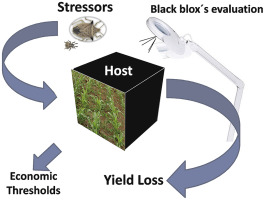当前位置:
X-MOL 学术
›
Crop Prot.
›
论文详情
Our official English website, www.x-mol.net, welcomes your
feedback! (Note: you will need to create a separate account there.)
Dichelops melacanthus and Euschistus heros injury on maize: Basis for re-evaluating stink bug thresholds for IPM decisions
Crop Protection ( IF 2.5 ) Pub Date : 2020-04-01 , DOI: 10.1016/j.cropro.2019.105050 Emerson Crivelaro Gomes , Rafael Hayashida , Adeney de Freitas Bueno
Crop Protection ( IF 2.5 ) Pub Date : 2020-04-01 , DOI: 10.1016/j.cropro.2019.105050 Emerson Crivelaro Gomes , Rafael Hayashida , Adeney de Freitas Bueno

|
Abstract This study compared injuries caused by different densities of adults and nymphs of Dichelops melacanthus and Euschistus heros to better assess the stink bug economic threshold (ET) for maize in integrated pest management. Thus, four different trials were conducted in Londrina, Brazil from 2017 to 2018 in the greenhouse and under field conditions. The first and second trial compared the degree of injuries caused by different adult densities of D. melacanthus and E. heros on maize, using artificial infestation. The third trial compared the capacity of adults and nymphs of both species to injury maize. The fourth trial evaluated different ETs under field conditions. The study demonstrated that the ET for stink bugs in maize should be three adults of D. melacanthus m−1 of row. A lower ET triggered a higher number of insecticide applications, but did not improve either yield or net income, as shown by economic analysis. Moreover, the potential of E. heros for damaging maize was shown to be low. The results show the control is not justified for densities up to 6 stink bugs m−1 of row, since yield was not reduced at these densities. Also, stink bug nymphs and adults might not produce the same injuries. Not only were adults of D. melacanthus more harmful to maize than nymphs of the same species but also than adults or nymphs of E. heros. Further research comparing the insect damage caused by different developmental stages is still needed in order to refine current ETs for future application.
中文翻译:

Dichelops melacanthus 和 Euschistus 对玉米的伤害:重新评估 IPM 决策的臭虫阈值的基础
摘要 本研究比较了不同密度的黑蛉成虫和若虫造成的伤害,以更好地评估玉米病虫害综合治理中的臭虫经济阈值(ET)。因此,2017 年至 2018 年在巴西隆德里纳的温室和田间条件下进行了四项不同的试验。第一次和第二次试验比较了不同成虫密度的 D. melacanthus 和 E. heros 使用人工侵染对玉米造成的伤害程度。第三项试验比较了两个物种的成虫和若虫对玉米的伤害能力。第四次试验在现场条件下评估了不同的 ET。该研究表明,玉米中臭虫的 ET 应该是 D. melacanthus m-1 行的三个成虫。较低的 ET 引发了更多的杀虫剂应用,但正如经济分析所显示的那样,并没有提高收益率或净收入。此外,E. heros 破坏玉米的潜力被证明是低的。结果表明,对于高达 6 个臭虫 m-1 行的密度,控制是不合理的,因为在这些密度下产量没有降低。此外,臭虫若虫和成虫可能不会产生相同的伤害。D. melacanthus 的成虫不仅比同种的若虫对玉米的危害更大,而且比 E. heros 的成虫或若虫对玉米的危害更大。仍需要进一步研究比较不同发育阶段造成的昆虫损害,以完善当前的 ETs 以供未来应用。结果表明,对于高达 6 个臭虫 m-1 行的密度,控制是不合理的,因为在这些密度下产量没有降低。此外,臭虫若虫和成虫可能不会产生相同的伤害。D. melacanthus 的成虫不仅比同种的若虫对玉米的危害更大,而且比 E. heros 的成虫或若虫对玉米的危害更大。仍需要进一步研究比较不同发育阶段造成的昆虫损害,以完善当前的 ETs 以供未来应用。结果表明,对于高达 6 个臭虫 m-1 行的密度,控制是不合理的,因为在这些密度下产量没有降低。此外,臭虫若虫和成虫可能不会产生相同的伤害。D. melacanthus 的成虫不仅比同种的若虫对玉米的危害更大,而且比 E. heros 的成虫或若虫对玉米的危害更大。仍需要进一步研究比较不同发育阶段造成的昆虫损害,以完善当前的 ETs 以供未来应用。
更新日期:2020-04-01
中文翻译:

Dichelops melacanthus 和 Euschistus 对玉米的伤害:重新评估 IPM 决策的臭虫阈值的基础
摘要 本研究比较了不同密度的黑蛉成虫和若虫造成的伤害,以更好地评估玉米病虫害综合治理中的臭虫经济阈值(ET)。因此,2017 年至 2018 年在巴西隆德里纳的温室和田间条件下进行了四项不同的试验。第一次和第二次试验比较了不同成虫密度的 D. melacanthus 和 E. heros 使用人工侵染对玉米造成的伤害程度。第三项试验比较了两个物种的成虫和若虫对玉米的伤害能力。第四次试验在现场条件下评估了不同的 ET。该研究表明,玉米中臭虫的 ET 应该是 D. melacanthus m-1 行的三个成虫。较低的 ET 引发了更多的杀虫剂应用,但正如经济分析所显示的那样,并没有提高收益率或净收入。此外,E. heros 破坏玉米的潜力被证明是低的。结果表明,对于高达 6 个臭虫 m-1 行的密度,控制是不合理的,因为在这些密度下产量没有降低。此外,臭虫若虫和成虫可能不会产生相同的伤害。D. melacanthus 的成虫不仅比同种的若虫对玉米的危害更大,而且比 E. heros 的成虫或若虫对玉米的危害更大。仍需要进一步研究比较不同发育阶段造成的昆虫损害,以完善当前的 ETs 以供未来应用。结果表明,对于高达 6 个臭虫 m-1 行的密度,控制是不合理的,因为在这些密度下产量没有降低。此外,臭虫若虫和成虫可能不会产生相同的伤害。D. melacanthus 的成虫不仅比同种的若虫对玉米的危害更大,而且比 E. heros 的成虫或若虫对玉米的危害更大。仍需要进一步研究比较不同发育阶段造成的昆虫损害,以完善当前的 ETs 以供未来应用。结果表明,对于高达 6 个臭虫 m-1 行的密度,控制是不合理的,因为在这些密度下产量没有降低。此外,臭虫若虫和成虫可能不会产生相同的伤害。D. melacanthus 的成虫不仅比同种的若虫对玉米的危害更大,而且比 E. heros 的成虫或若虫对玉米的危害更大。仍需要进一步研究比较不同发育阶段造成的昆虫损害,以完善当前的 ETs 以供未来应用。









































 京公网安备 11010802027423号
京公网安备 11010802027423号